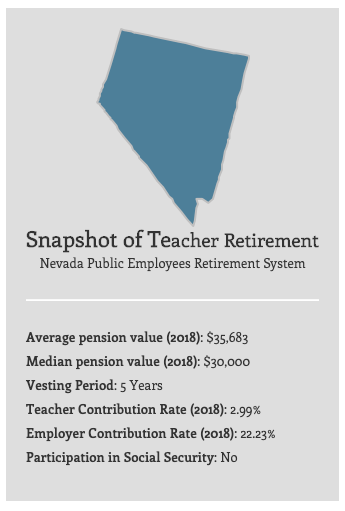
Snapshot of Teacher Retirement
Nevada Public Employees Retirement System
Average pension value (2018): $35,683
Median pension value (2018): $30,000
Vesting Period: 5 Years
Teacher Contribution Rate (2018): 2.99%
Employer Contribution Rate (2018): 22.23%
Participation in Social Security: No
How Do Teacher Pensions Work in Nevada?
In Nevada, teachers are a part of the Nevada Public Employees' Retirement System, which includes not only teachers but all state employees. The NVPERS was established in 1947.
The basic structure of Nevada’s teacher defined benefit (DB) pension is similar to that of other states. Unlike other retirement funds, a teacher’s contributions and those made on their behalf by the state or school district do not determine the value of the pension at retirement. Although those contributions are invested in the market, and often managed by private equity and hedge funds, a teacher’s pension wealth is not derived from the returns on those investments. Instead, it is determined by a formula based on their years of experience and final salary.
How Are Teacher Pensions Calculated in Nevada?
Pension wealth is derived from a formula. The figure below illustrates how a teacher pension is calculated in Nevada. It is important to note, however, that the state assesses an educator’s final salary based on their highest average 36 consecutive months of salary. For example, a teacher who works for 25 years with a final average salary of $70,000 would be eligible for an annual pension benefit worth 56 percent of their final salary.
Calculating Teacher Pension Wealth in Nevada
| 2.25% Multiplier | X | Avg. highest 36 consecutive months of salary | X | Years of service |
Who Qualifies for a Teacher Pension in Nevada?
Like most states, teachers need to serve a number of years before qualifying for a pension. Nevada has a 5 year vesting period. While educators qualify for a pension after 5 years of service, the pension may not be worth all that much. Moreover, educators can’t begin to collect it until they hit the state’s retirement age.
The state sets specific windows when teachers can retire with benefits based on age and years of experience. New teachers starting out in Nevada can retire:
- At 55 with 33.3 years of experience;
- At 55 with 30 years of experience;
- At 62 with 10 years of experience; or,
- At 65 with 5 years of experience.
Additionally, Nevada allows early retirement, but subtracts 6 percent from the monthly benefit for each early year.
How Much Does Nevada's Teacher Pension Plan Cost?
As they work, teachers and their employers must contribute into the plan. Those contribution rates are set by the state legislature and can change year-to-year. In 2018, teachers contributed 2.99 percent of their salary to the pension fund, while the state contributed 22.23 percent. In total, 25.22 percent of teacher salary was spent on Nevada's teacher pension fund. However, not all of that investment goes toward benefits. While the full 2.99 percent of salary contributed by individual teachers is for benefits, the state contributes only 13.4 percent. The remaining 8.83 percent state contribution is to pay down the pension fund's debt.
Finally, in Nevada, as with most states, teacher pensions are not portable. This means that if a teacher leaves the NVPERS system, they can’t take their benefits with them, even if they continue working in the teaching profession. As a result, someone who leaves teaching or who moves across state lines might have two pensions, but the sum of those two pensions is likely to be worth less than if they remained in one system for their entire career. In other words, the lack of benefit portability will hurt the long-term retirement savings of any educator who leaves teaching altogether or who crosses state lines to work in another state.
As with most state pension funds, Nevada’s teacher retirement system provides the greatest benefits to teachers who stay the longest, while leaving everyone else with inadequate benefits. With that in mind, new and current teachers in Nevada should think carefully about their career plans and how they interact with the state's retirement plan.
Glossary of Financial Terms
Vesting period: The number of years a teacher must teach before becoming eligible to receive a pension. Although the length of vesting periods vary by state, 5 years is typical. In every state, a teacher who leaves prior to vesting is eligible to withdraw his or her own contributions, sometimes with interest, but few states allow those employees to collect any portion of the employer contributions made on their behalf.
Employee contribution: The percent of a teacher’s salary that he or she pays annually to the pension fund.
Employer contribution: The percent of a teacher’s salary that the state, school district, or a combination of the two pays annually to the pension fund.
Normal cost: The annual cost of retirement benefits as a percentage of teacher salary. This excludes any debt cost.
Amortization cost: The annual cost of a pension fund’s contribution toward any unfunded liabilities. This can also be thought of as the debt cost of the pension fund.
https://www.teacherpensions.org/state/nevada

